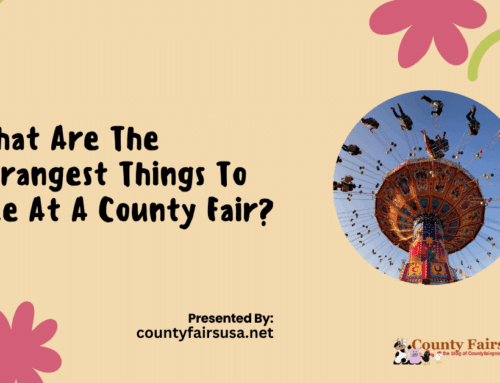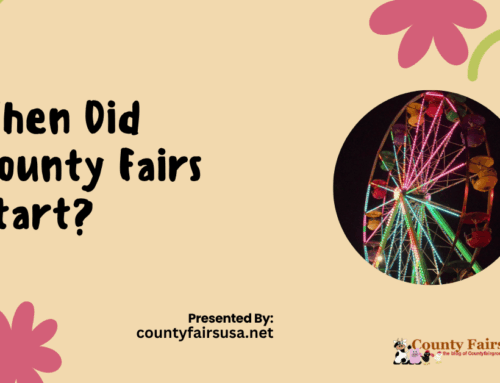Few traditions capture the heart of American life quite like the county fair. These annual events, rich in both history and hometown flavor, have been bringing communities together for over two centuries.
What started as simple agricultural gatherings has steadily evolved into a vibrant mix of food, fun, livestock, music, and local pride. From hay-strewn barns to neon-lit midways, the county fair has grown with the country itself adapting to shifting lifestyles while holding on to the customs that make it feel timeless.
The Evolution of County Fairs in the USA
In this article, we’ll explore how county fairs in the USA have changed over the years, and why they continue to matter today.
From Humble Beginnings: The Early Agricultural Fairs
The first official county fair in the United States was held in 1811 in Berkshire County, Massachusetts. Organized by Elkanah Watson, the goal was to promote better livestock breeding and farming practices. Farmers would bring their best animals, tools, and crops to share knowledge, compete for prizes, and inspire innovation.
During the 19th century, these fairs became more common across New England and the Midwest. Agricultural societies were the driving force behind them, aiming to raise standards in farming and homemaking. These early fairs were practical in nature, with a strong educational focus and a deep connection to rural life.
Late 1800s: Expanding Beyond the Farm
As the United States grew in population and diversity, so did county fairs. By the late 1800s, fairs were no longer just for farmers. The addition of cooking contests, craft displays, and public lectures made them more inclusive. Railroads played a crucial role in this expansion, allowing more people to attend and more exhibits to be transported.
While agriculture still held center stage, other aspects of rural and domestic life started gaining attention. County fairs became a celebration of community, offering something for nearly everyone.
Early 20th Century: Entertainment Joins the Scene
By the early 1900s, county fairs began to include elements of fun and spectacle. With cities growing and leisure time becoming more common, fair organizers recognized the need to attract a broader audience.
Popular additions during this era included:
- Mechanical rides like carousels and Ferris wheels
- Midway games featuring ring tosses and shooting galleries
- Performers such as magicians, strongmen, and traveling musicians
- Food stands offering simple, affordable treats like popcorn and lemonade
Fairs still celebrated agriculture, but the draw of thrill and novelty became just as important for drawing crowds.
Post-WWII: A National Tradition Takes Hold
Following World War II, the county fair experienced what many call its golden age. The economic growth of the 1950s and 1960s allowed counties to invest more in fairgrounds, entertainment, and infrastructure.
Families across the country made attending the fair a summer tradition. Grandstand events such as demolition derbies, horse races, and country music concerts became key attractions. Television exposure and celebrity appearances made fairs feel more modern and connected to national culture.
Meanwhile, youth organizations like 4-H and FFA (Future Farmers of America) gained visibility, reinforcing agricultural education and keeping the fair rooted in its origins.
Late 20th Century: Adapting to a Changing America
As urbanization spread and fewer people lived on farms, the purpose of county fairs shifted. While livestock shows and crop displays remained, many fairs had to appeal to new audiences with different expectations.
Features that became more prominent included:
- Petting zoos for young children
- Craft vendors selling handmade soaps, candles, and jewelry
- International food stalls offering a wide range of flavors
- Talent shows and pageants for local youth
Fairs in this era began blending nostalgic traditions with modern preferences, creating a more diverse experience for attendees.
Today’s County Fairs: Old Meets New
Modern county fairs reflect a delicate balance between past and present. In many ways, they still represent the values of rural America hard work, family, and local pride but they also incorporate contemporary themes.
You’re just as likely to see a tractor-pulling contest as you are a smartphone photography competition. While classic funnel cakes and corn dogs are always present, so are vegan food trucks and gourmet coffee stands.
Many fairs now use apps to provide maps, schedules, and updates. Some offer wristbands for contactless entry and rides. Even social media plays a part, with fairs encouraging visitors to share their experiences online.
Time-Honored Traditions That Still Shine
Despite the many changes, some county fair staples continue to hold their charm and importance. Here are a few traditions that haven’t lost their place:
- Livestock Shows: Cattle, sheep, pigs, and poultry remain at the heart of most fairs.
- Homemade Goods: Canning competitions, pies, and quilts still earn blue ribbons.
- Midway Rides: The Ferris wheel and tilt-a-whirl remain must-rides for families.
- 4-H and FFA Booths: Youth-led projects in farming, science, and art keep kids involved.
- Live Music: Local and regional bands provide evening entertainment.
- Community Awards: Recognition for achievements in gardening, baking, and craftsmanship.
These enduring elements are what keep generations of families returning year after year.
Modern Challenges and Smart Solutions
Running a successful county fair today is not without its challenges. Rising costs, changing demographics, and environmental concerns require fair organizers to be thoughtful and adaptive.
Recent challenges include:
- Weather unpredictability: Fairs often plan around extreme heat, storms, or droughts.
- Health and safety regulations: Particularly since the pandemic, public safety has been a higher priority.
- Budget constraints: Balancing affordability for guests while supporting vendors and staff.
- Sustainability concerns: Efforts are increasing to reduce waste, promote recycling, and use renewable energy on fairgrounds.
Many fairs now rely on a mix of public funding, sponsorships, and community volunteers to continue their operations.
Why County Fairs Still Matter
Even in a world of digital entertainment and busy schedules, county fairs offer something uniquely personal and rooted in community.
Here’s why they remain relevant:
- They bring people together neighbors, families, and visitors from across the region.
- They showcase local talent, from bakers and farmers to musicians and artists.
- They support local economies, giving small vendors and artisans a chance to sell directly.
- They preserve history, offering younger generations a chance to connect with their heritage.
County fairs are more than just a few days of fun they’re reminders of what communities can achieve when they come together.
Conclusion
The county fair has come a long way since the early 1800s. What began as a gathering of farmers showing off their livestock has grown into an experience filled with food, games, culture, and tradition. Yet, at its core, the fair still celebrates the same values: hard work, creativity, and community.
Whether you’re in it for the funnel cake, the 4-H competition, or the simple joy of watching fireworks on a summer night, the county fair continues to offer a space where old and new traditions meet. And in doing so, it holds a special place in the American story.










Leave A Comment